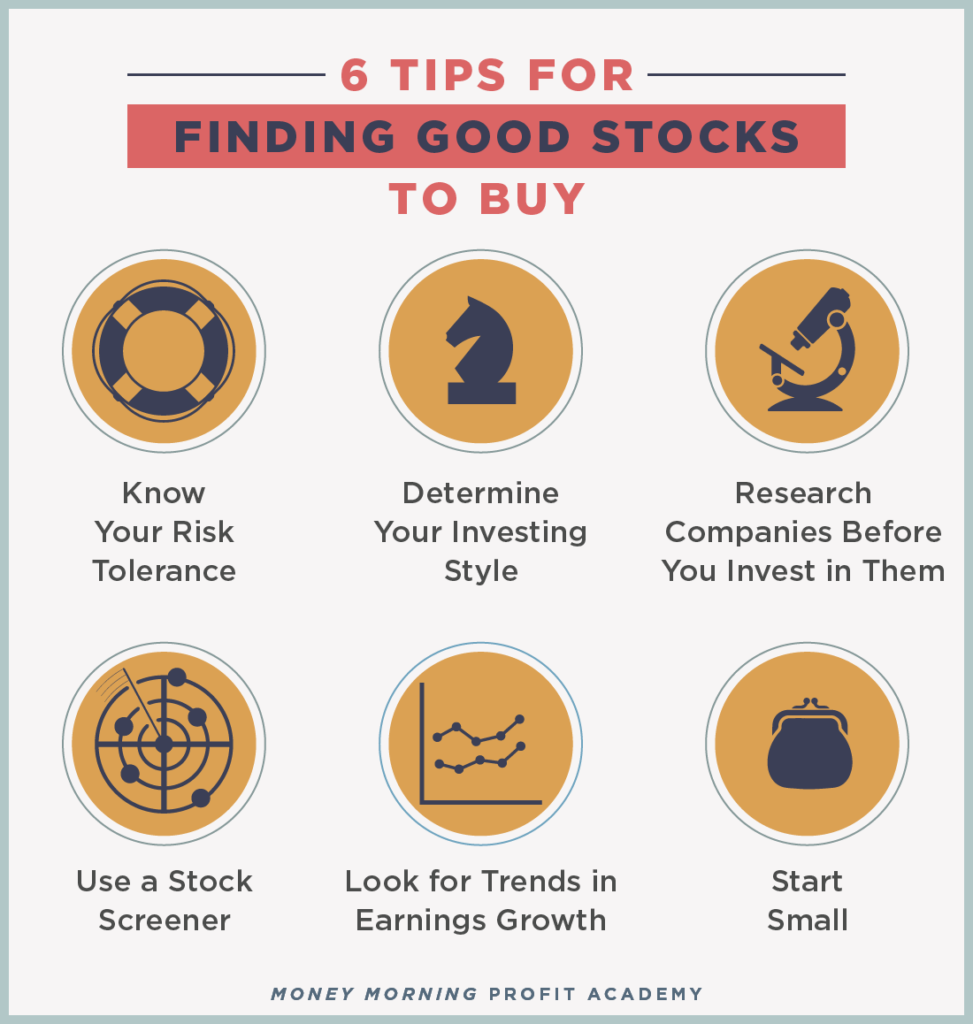
Learning how to find good stocks to buy starts with understanding your investing style, risk tolerance, and stock trends. It also starts with research (and a lot of it). But don’t worry – that’s where the Money Morning Profit Academy comes in.
The tips in this lesson will help you become an informed, confident investor who knows what to look for when approaching the stock market and researching the best stocks to buy.
Ready to learn how to pick good stocks that have a likelihood of strong returns? Let’s get started.

1. Know Your Risk Tolerance
Earlier in the course, we learned how to balance investing risks and goals, and what that means for your portfolio.
Risk tolerance refers to how much risk you’re willing to take with your investments and is unique to each investor. Your risk tolerance can change throughout your life, depending on your goals.
The best stocks for your risk tolerance and goals will likely look different than the best stocks for your friends or family members. Everyone has different goals and net worth, which will affect the level of risk you’re willing to take – and your portfolio should reflect that.
When looking for good stocks to buy, consider:
- The timeline for your goals
- How liquid (or accessible) you want your assets to be
- Your comfort level with investing in smaller startups
- How much you want to invest in stable, lower-return stocks.
All of these considerations will be unique to you and will help you find good stocks to buy for your portfolio.
2. Determine Your Investing Style
Just as every investor has a different appetite for risk, each investor has their own investing style. Your investing style depends on how much time you want to devote to watching market trends and movements, how much risk you are willing to take, your investment goals, your timeline for investing, and more.
Here are a few questions to ask yourself when considering your investing style:
- Are you looking for short-term profits?
- How much time do you want to dedicate to studying market movement?
- Do you prefer a “set it and forget it” strategy?
- Do you want to be able to reinvest dividends from your stocks?
3. Research Companies Before You Invest in Them
Finding good stocks is all about research.
Although it seems like a simple transaction, buying a stock is buying a share in that company, so you want to make sure you do your research before investing. It’s important to know the company you’re investing in because as a shareholder, you will be directly impacted by the company’s decisions.
Here are some questions to ask yourself as you research if a company is a good fit for your portfolio:
- What does the company do?
- How does the company make money?
- What does the future of this industry look like?
- Do you trust the company’s management, and are the values of management aligned with the values of stakeholders?
- How does the company’s balance sheet look?
- Do you have insight into their financials?
- What is their debt-to-equity ratio?
- What is the company’s EPS (earnings per share)?
- Do they have a competitive advantage?
Questions like these will help you examine both the quantitative and qualitative aspects of a stock and company.
4. Use a Stock Screener
Stock screeners are excellent tools to help you find good stocks to buy and can save you a lot of time. A stock screener lets you filter through hundreds of stocks based on certain parameters you set like market cap, share price, sector, price-to-earnings (P/E) ratio, and more.
There are dozens of free stock screening tools you can find online, such as this one from finviz. They might look different but follow the same idea: you can select the metric you want to use and input the value you want to screen for. All you have to do is hit the “Run Screen” button, and you’ll see every stock that fits your criteria. You can continue adding more criteria to your screen to narrow down the field and focus on the stocks that are best for you.
5. Look for Trends in Earnings Growth
To find good stocks to buy, look for companies that have increased their earnings over time. Increased earnings are a good sign, but you also need to look at the value of a stock to decide if it’s worth the investment. Earnings growth and value should go hand-in-hand. [Custom image visualizing earnings growth and value] The stock market has a few variables that track this relationship to help investors find good stocks to buy:
Price-to-Book (P/B Ratio)
The price-to-book ratio (P/B ratio) values a company as if it were to be disassembled and sold today. This value score can include everything from earnings and equipment, to buildings, land, stock holdings, and bonds. It provides a value for everything the company could hypothetically sell.
Price-to-Earnings (P/E Ratio)
The price-to-earnings ratio (P/E ratio) is a great metric to look at when valuing stocks outside of just earnings growth. It helps investors determine whether a stock will stay up after a significant increase, or if it will just fall back down.
You can compare P/E ratios of stocks in similar industries, such as energy, healthcare, or biotech. You can think of this metric as how long it will take a stock to pay back your investment.
You can also use a stock’s P/E ratio to find potentially undervalued stocks. Remember: we’re not just interested in stocks that have a low share price (which could mean that they’re not worth buying).
Instead, we’re looking for stocks that are inexpensive to own, but offer good value for their price. A “good” P/E ratio will depend on several factors, but 16-20 is usually a good starting point.
Price-to-Earnings Growth (PEG) Ratio
Another ratio that the market uses to determine good stocks to buy is the price-to-earnings growth (PEG) ratio. The PEG ratio also incorporates a company’s historical growth rate in terms of earnings by taking a company’s P/E ratio and dividing it by the year-over-year growth rate of its earnings.
6. Start Small
Investing can be overwhelming, but getting started is the first step, and it’s better to start small than not at all. Find a stock to invest in and monitor its performance, looking for trends along the way. This can help you ease into investing and build your confidence.
Think You Know How to Pick Good Stocks?
We’ve given you a lot of information throughout these lessons and we hope you feel more confident about building a profitable stock portfolio, picking good stocks, and building an investment strategy that’s right for you.
Our goal is to educate you about your options and help alleviate common fears that new investors have when they begin investing in the stock market. Ready to see how much you learned? Take the end-of-module quiz to test your knowledge.


